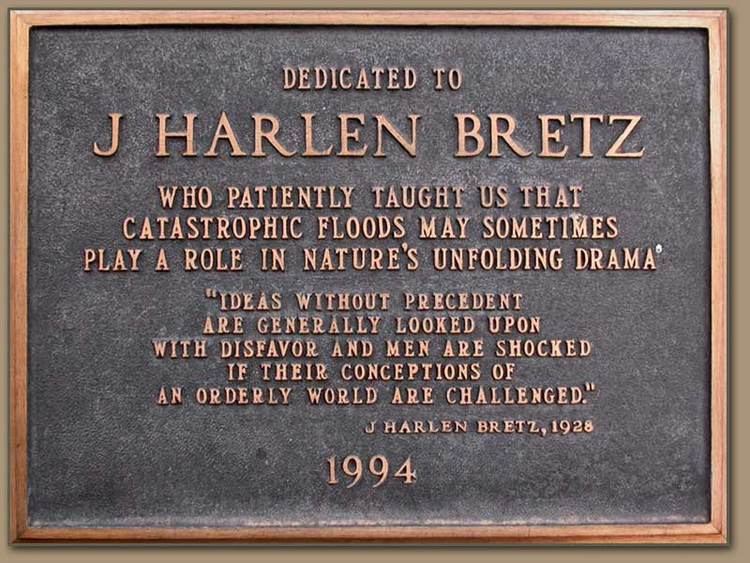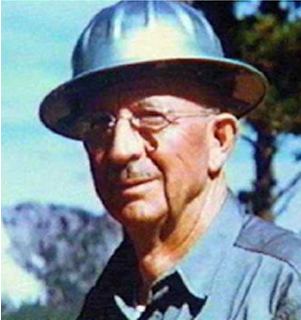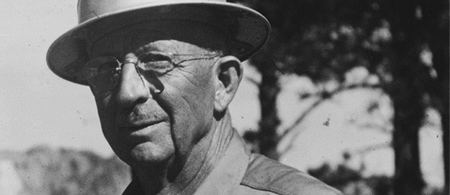Nationality American Name J Bretz Awards Penrose Medal | Influences Joseph Thomas Pardee Role Geologist | |
 | ||
Born September 2, 1882 ( 1882-09-02 ) Other names Harlan J. Bretz, Harland J. Bretz Alma mater Albion College, AB 1905University of Chicago, Ph.D. geology 1913 Books Caves of Missouri, Glaciation of the Puget Sound Region Education University of Chicago, Albion College | ||
J Harlen Bretz SS Presentation
J Harlen Bretz (September 2, 1882 – February 3, 1981) was an American geologist, best known for his research that led to the acceptance of the Missoula Floods and for his work on caves. He was born to Oliver Joseph Bretz and Rhoda Maria Howlett, farmers in Saranac, Michigan, the oldest of five children. He earned a degree in biology from Albion College in 1905, where he also met his wife Fanny Chalis. Thereafter, he became interested in the geology of Eastern Washington State.
Contents
- J Harlen Bretz SS Presentation
- Early career
- Outrageous hypothesis
- Caves and karst
- Awards and honours
- References

Early career

Bretz was of German heritage. Bretz graduated with his AB from Albion College in 1905. He then started his career as a high school biology teacher in Seattle. During this time he began studying the glacial geology of the Puget Sound area. He continued his studies at the University of Chicago where he earned his Ph.D. in geology in 1913. He became an assistant professor of geology, first at the University of Washington and then the University of Chicago.
He made important discoveries regarding the origin of the Channeled Scablands.
Outrageous hypothesis
In the summer of 1922, and for the next seven years, Bretz conducted field research of the Columbia River Plateau. Since 1910 he had been interested in unusual erosion features in the area after seeing a newly published topographic map of the Potholes Cataract. Bretz coined the term Channeled Scablands in 1923 to describe the area near the Grand Coulee, where massive erosion had cut through basalt deposits. The area was a desert, but Bretz's theories required cataclysmic water flows to form the landscape, for which Bretz coined the term Spokane Floods in a 1925 publication.
Bretz published a paper in 1923, arguing that the channeled scablands in Eastern Washington were caused by massive flooding in the distant past. This was seen as arguing for a catastrophic explanation of the geology, against the prevailing view of uniformitarianism, and Bretz's views were initially discredited. However, as the nature of the Ice Age was better understood, Bretz's original research was vindicated, and by the 1950s his conclusions were also vindicated.
Bretz encountered resistance to his theories from the geology establishment of the day. The geology establishment was resistant to such a sweeping theory for the origin of a broad landscape for a variety of reasons, including lack of familiarity with the remote areas of the interior Pacific Northwest where the research was based, and the lack of status and reputation of Bretz in the eyes of the largely Ivy League-based geology elites. Furthermore, his theory implied the potential possibilities of a Biblical flood, which the scientific community strongly rejects. The Geological Society of Washington, D.C invited the young Bretz to present his previously published research at a 12 January 1927 meeting where several other geologists presented competing theories. Bretz saw this as an ambush, and referred to the group as six "challenging elders". Their intention was to defeat him in a public debate, and thereby end the challenge his theories posed to their conservative interpretation of uniformitarianism.
Another geologist at the meeting, J.T. Pardee, had worked with Bretz and had evidence of an ancient glacial lake that lent credence to Bretz's theories. Pardee, however, lacked the academic freedom of Bretz (he worked for the US Geological Survey) and did not enter the fray.
Bretz defended his theories, kicking off an acrimonious 40 year debate over the origin of the Scablands. As he wrote in 1928, "Ideas without precedent are generally looked upon with disfavour and men are shocked if their conceptions of an orderly world are challenged."
Both Pardee and Bretz continued their research over the next 30 years, collecting and analyzing evidence that eventually identified Lake Missoula as the source of the Spokane Floods and creator of the Channeled Scablands. Research on open channel hydraulics in the 1970s further vindicated Bretz's and Pardee's theories.
Caves and karst
Bretz wrote an extremely influential paper on the morphology and origin of limestone caves (1942) together with detailed studies of the caves of Missouri (1956) and Illinois (with Stanley Harris, 1961).
Awards and honours
The National Speleological Society made Bretz an honorary member in 1954.
Bretz received the Penrose Medal; the Geological Society of America's highest award, in 1979, at the age of 96. After this award, he told his son: "All my enemies are dead, so I have no one to gloat over."
Each year at Albion College, the J Harlen Bretz Award is given to the most outstanding senior in the geology department.
